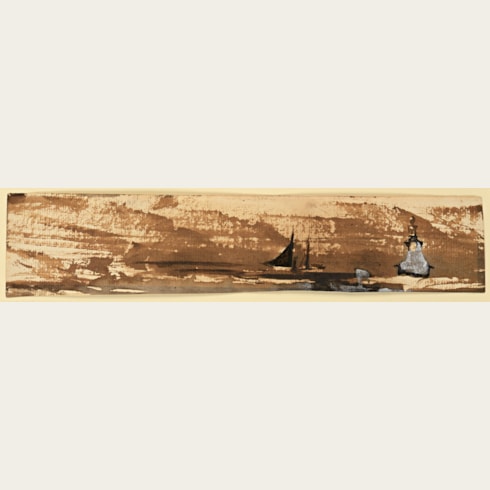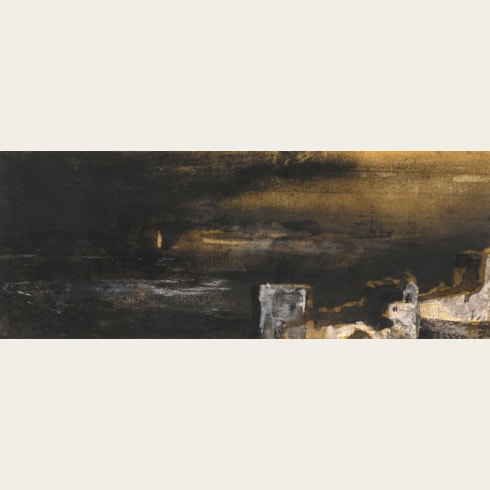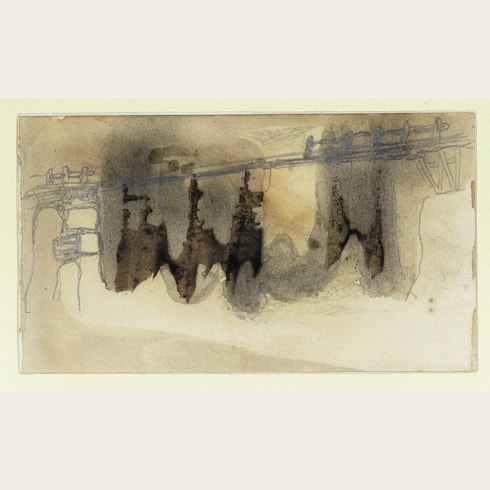Victor HUGO
(Besançon 1802 - Paris 1885)
Landscape with a Castle
Sold
Pen, brush and brown ink and brown wash.
Signed with initials and dated V. H. 20 7bre 1842 at the lower right.
92 x 188 mm. (3 5/8 x 7 3/8 in.)
Signed with initials and dated V. H. 20 7bre 1842 at the lower right.
92 x 188 mm. (3 5/8 x 7 3/8 in.)
The present sheet may be associated with drawings made in Victor Hugo’s notebooks during his travels along the Rhine in 1838, 1839 and 1840, in the company of his lover Juliette Drouet. On these journeys he was particularly captivated by the numerous, imposing mountaintop castles, or burgs, which appeared in towns here and there along the course of the majestic river, and he made pencil sketches of many of the picturesque sites they visited in his travel diaries and notebooks, as well as in letters sent to his family and relatives. This voyage inspired Hugo’s great book Le Rhin: Lettres à un ami, published in three volumes between 1842 and 1845; this was a sort of travel guide in which he included reflections, anecdotes and Rhine legends, along with descriptive passages of the places he visited.
After travelling through France and Belgium to reach the Rhine, Hugo’s book takes the reader along the course of the great river, from Cologne to the cataract of the Rhine Falls in Switzerland. In Le Rhin, the writer, referring to himself, noted that ‘The encounter with this great river produced in him what no incident of his journey had inspired in him until that moment; a will to see and observe with a determined aim fixed the wandering course of his ideas, gave a precise meaning to his at first capricious excursion, gave a centre to his studies, in a word, made him pass from reverie to thought. The Rhine is the river of which all the world speaks and which no one studies, that everyone visits and no one knows, which one notices as one passes by and which one quickly forgets, which every glance touches and which no one penetrates spiritually. Yet its ruins occupy lofty imaginations, its destiny occupies serious minds; and this admirable river, through its transparent waves, allows the eye of the poet as well as that of the publicist to see the past and future of Europe.’
Hugo’s voyage along the Rhine in 1840, the longest of his journeys on the great river, was spent partly on board a steamship, and allowed him ample time to record his observations. As his friend and contemporary biographer Alfred Barbou noted of this period, ‘About this time he wrote “Le Rhin”, a work that exhibits another side of his genius. This consists of a series of letters, supposed to be written to a friend, giving a humorous account of an archaeological tour. The style is racy, but affords the author every opportunity of illustrating his wide erudition. Under the character of a goodnatured savant he carries his readers from Aix-la-Chapelle to Cologne, thence to Mayence and Frankfort, visiting the numerous monuments on his way, relating the various legends connected with town, village, or castle, digressing into philosophy and politics, and introducing a number of graphic stories full of interest and amusement. He sketches as he goes, and his drawings manifest his unbounded admiration of the scenery of the river and the old “burgs” upon its banks…His descriptions and his illustrations are equally admirable; the painter and the poet go hand-in-hand.’
It is after his trips along the Rhine that Hugo’s pen and ink drawings take on a more visionary aspect, inspired by the poetic sights he saw, and in particular the sequence of over thirty ruined castles – ‘forteresses à demi écroulées’, in Hugo’s words – on the high ground overlooking the river between Koblenz and Mainz. As the modern scholar Pierre Georgel has noted, with his book Le Rhin Hugo ‘finally passed from a picturesque manner to the contemplative vision in which his genius was to find mature expression. At the same time, the draughtsman’s most obsessive themes began to crystallize around the memorable image of the burg…After the journey of 1840, which, for several weeks, concentrated Hugo’s imagination on the dark outlines of the Rhenish Burgs, dreams of a more obscure kind poured out into his drawings. A whole world began to be formed around signs recollected from memory – ruined castles, outlines of towns by the waterside.’ Sketches and descriptions of castles or burgs occur frequently in Hugo’s drawings, notebooks and letters, and indeed castles play a significant role in much of his published work.
The first owner of this small drawing was the lawyer, journalist, politician and bibliophile Jean Louis Barthou (1862-1934), who briefly served as prime minister of France in 1913, and who published a number of books and articles about Victor Hugo. A stylistically comparable drawing of a Rhine landscape by Hugo of the same date, also at one time in the Barthou collection, is today in the Louvre, on loan to the Musée Victor Hugo-Maison Vacquerie in Villequier.
After travelling through France and Belgium to reach the Rhine, Hugo’s book takes the reader along the course of the great river, from Cologne to the cataract of the Rhine Falls in Switzerland. In Le Rhin, the writer, referring to himself, noted that ‘The encounter with this great river produced in him what no incident of his journey had inspired in him until that moment; a will to see and observe with a determined aim fixed the wandering course of his ideas, gave a precise meaning to his at first capricious excursion, gave a centre to his studies, in a word, made him pass from reverie to thought. The Rhine is the river of which all the world speaks and which no one studies, that everyone visits and no one knows, which one notices as one passes by and which one quickly forgets, which every glance touches and which no one penetrates spiritually. Yet its ruins occupy lofty imaginations, its destiny occupies serious minds; and this admirable river, through its transparent waves, allows the eye of the poet as well as that of the publicist to see the past and future of Europe.’
Hugo’s voyage along the Rhine in 1840, the longest of his journeys on the great river, was spent partly on board a steamship, and allowed him ample time to record his observations. As his friend and contemporary biographer Alfred Barbou noted of this period, ‘About this time he wrote “Le Rhin”, a work that exhibits another side of his genius. This consists of a series of letters, supposed to be written to a friend, giving a humorous account of an archaeological tour. The style is racy, but affords the author every opportunity of illustrating his wide erudition. Under the character of a goodnatured savant he carries his readers from Aix-la-Chapelle to Cologne, thence to Mayence and Frankfort, visiting the numerous monuments on his way, relating the various legends connected with town, village, or castle, digressing into philosophy and politics, and introducing a number of graphic stories full of interest and amusement. He sketches as he goes, and his drawings manifest his unbounded admiration of the scenery of the river and the old “burgs” upon its banks…His descriptions and his illustrations are equally admirable; the painter and the poet go hand-in-hand.’
It is after his trips along the Rhine that Hugo’s pen and ink drawings take on a more visionary aspect, inspired by the poetic sights he saw, and in particular the sequence of over thirty ruined castles – ‘forteresses à demi écroulées’, in Hugo’s words – on the high ground overlooking the river between Koblenz and Mainz. As the modern scholar Pierre Georgel has noted, with his book Le Rhin Hugo ‘finally passed from a picturesque manner to the contemplative vision in which his genius was to find mature expression. At the same time, the draughtsman’s most obsessive themes began to crystallize around the memorable image of the burg…After the journey of 1840, which, for several weeks, concentrated Hugo’s imagination on the dark outlines of the Rhenish Burgs, dreams of a more obscure kind poured out into his drawings. A whole world began to be formed around signs recollected from memory – ruined castles, outlines of towns by the waterside.’ Sketches and descriptions of castles or burgs occur frequently in Hugo’s drawings, notebooks and letters, and indeed castles play a significant role in much of his published work.
The first owner of this small drawing was the lawyer, journalist, politician and bibliophile Jean Louis Barthou (1862-1934), who briefly served as prime minister of France in 1913, and who published a number of books and articles about Victor Hugo. A stylistically comparable drawing of a Rhine landscape by Hugo of the same date, also at one time in the Barthou collection, is today in the Louvre, on loan to the Musée Victor Hugo-Maison Vacquerie in Villequier.
The preeminent literary figure in 19th century France, Victor Hugo was also an accomplished and prolific draughtsman. He produced nearly three thousand drawings, the principal groups of which are today in the collections of the Bibliothèque Nationale and the Maison de Victor Hugo in Paris. He began to draw seriously around 1825, but relatively little of this early work survives and it was not until some twenty years later that he was to develop his distinctive personal idiom. Hugo seems to have been most productive as a draughtsman during periods when he was writing less, as for example in 1850. Conversely, there are very few drawings from the period between 1852 and 1853, when he was engaged on a spell of intense literary activity. His drawings achieved a height of expression during the years of his political exile from France on the Channel Islands of Jersey, where he and his family lived from 1852 to 1855, and Guernsey, where he settled in 1855 and remained until 1870. Although he often gave drawings as presents to friends and colleagues, and allowed several sheets to be reproduced as engravings, the act of drawing for Hugo remained a largely private occupation. In the last ten years of his life, he drew much less, a decline mirrored in his literary output.
As a draughtsman, Hugo relied primarily on brown or black ink and wash, applied with a fluidity and transparency that allowed for remarkable tonal and atmospheric effects. His idiosyncratic working methods have been described by his son Charles Hugo: ‘Once paper, pen and ink-well have been brought to the table, Victor Hugo sits down and without making a preliminary sketch, without any apparent preconception, sets about drawing with an extraordinarily sure hand not the landscape as a whole but any old detail. He will begin his forest with the branch of a tree, his town with a gable, his gable with a weather vane, and, little by little, the entire composition will emerge from the blank paper with the precision and clarity of a photographic negative subjected to the chemical preparation that brings out the picture. That done, the draftsman will ask for a cup and will finish off his landscape with a light shower of black coffee. The result is an unexpected and powerful drawing that is often strange, always personal, and recalls the etchings of Rembrandt and Piranesi.’
Hugo also experimented with different techniques and media, including inkblots (taches), folded paper, stencilled cut-outs, gold leaf and impressions taken from various objects, including leaves and lace.
Provenance
Louis Barthou, Paris
His sale (‘Bibliothèque de M. Louis Barthou de l’Académie Française’), Paris, Galerie Jean Charpentier, 4-6 November 1935, lot 1045
Anonymous sale, Paris, Sotheby’s, 21 June 2012, lot 102
Gérard Lhéritier (Aristophil), Nice.
His sale (‘Bibliothèque de M. Louis Barthou de l’Académie Française’), Paris, Galerie Jean Charpentier, 4-6 November 1935, lot 1045
Anonymous sale, Paris, Sotheby’s, 21 June 2012, lot 102
Gérard Lhéritier (Aristophil), Nice.
Literature
Louis Barthou, ‘Victor Hugo: carnets et dessins inédits’, Revue des deux mondes, December 1918, illustrated p.727 (as Les bords du Rhin).








